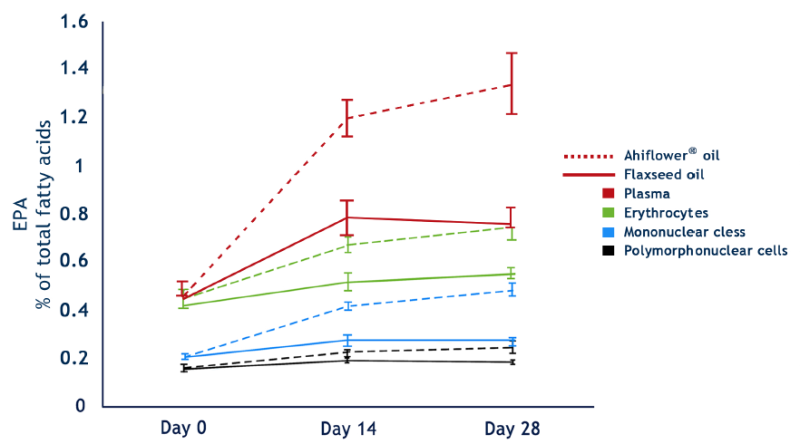Knowde Enhanced TDS
Identification & Functionality
- Ingredient Name
- Ingredient Origin
- Food Ingredients Functions
- Pharma & Nutraceuticals Functions
- Ingredients
- Ahiflower Seed Oil
Features & Benefits
- Food Ingredients Features
- Advantages
Advantages of Ahiflower® oil vs. Flaxseed oil
- 75% greater adjusted* total omega 3+6
- 18-20% SDA (Flax 0%)
- 5-8% GLA, comparable to Evening Primrose oil (Flax 0%)
- Converts to EPA up to 4X more efficiently
Advantages of Ahiflower® oil vs Chia oil
- 55% greater adjusted* total omega 3 +6
- 18-20% SDA (Chia 0%)
- 5-8% GLA (Chia 0%)
Advantages of Ahiflower® oil vs Echium oil
- 30% greater adjusted* total omega 3+6
- 60% more SDA
- More economical alternative
- More pleasing sensory properties
Advantages of Ahiflower® oil vs Hemp oil
- 40% greater adjusted* total omega 3 +6
- 10X more SDA
- 60% more GLA
- More pleasing sensory properties
Advantages of Ahiflower® oil vs Microalgae oil
- 18% total omega 6 (Microalgae 0%)
- More economical alternative
- Sustainable, non-GM, land-based sourcing
- More pleasing sensory properties
Advantages of Ahiflower® oil vs Fish or krill oil
- 5-8% GLA (Fish or krill oil 0%)
- Does not contribute to depletion of marine stocks
- No potential aquatic contaminants, heavy metals, or pollutants
- Neutral taste and smell-and no "fishy” burps
- Vegan/Vegetarian
- Benefits
- Support your cognitive health
- Support your joint health
- Support your cardiovascular health
- Support your healthy inflammatory response
- Support a healthy skin, hair and hormonal balance
- Up to 4X more effective than flaxseed oil
Applications & Uses
- Markets
- Applications
- Food & Nutrition Applications
Properties
- Physical Form
- Appearance
- Pale Yellow Liquid
- Flavor
- Rich (lightly nutty, grassy)
- Typical Properties
| Value | Units | Test Method / Conditions | |
| Monunsaturated Fat | 10 | % | — |
| Omega-3 Content | 65 (ALA & SDA) | % | — |
| Omega-3:6 Ratio | 3.6:1 | % | — |
| Omega-6 Content | 18 (LA & GLA) | % | — |
| Omega-9 Content | 10 | % | — |
| Oxidative Stability Index (110°C, hrs) | 31.93 | — | — |
| Polyunsaturated Fat | 83 | % | — |
| Saturated Fat | 7 | % | — |
| Smoke Point | 180 (356) | °C(°F) | — |
Regulatory & Compliance
- Certifications & Compliance
- Regulatory Status
Ahiflower® oil is a proprietary, licensed ingredient, offering distinctive leverage for best-in-class brand owners and formulators. Careful attention has been paid to relevant regulatory processes, including:
- FDA GRAS (Generally Recognized as Safe) review status with no objections
- EU Novel Foods approval
- NSF Non-GMO True North® Certified - Complies with EC Reg no. 182912003
- Health Canada NNHPD Approved - 1st NPN Issued February 2016
Ahiflower seeks global co-branding partners to formulate natural dietary supplement, functional food & beverage, animal nutrition and skin care products with Ahiflower oil.
Technical Details & Test Data
- Ahiflower oil leads to great EPA accrual in plasma and circulating cells vs. Flaxseed oil
ABSTRACT. Participants enrolled into the study were non- and low consumers of fatty fish; this was reflected in the concentrations of eicosapentaenoic acid (EPA) in serum, which were similar in both groups at baseline (AO: 44 and FO: 47uM, p=0.9). Following 28d of supplementation with AO, the concentration of serum EPA icreased to 138um (p<0.001), whereas the increase was not as remarkable in the FO group with a mean value of 81uM (p<0.001). EPA in serum, as a percentage of total Fas, increased in both groups after 14d (AO increased by 0.7%, p<0.001; FO increased by 0.3%, p<0.001) and 28d (AO: increased by 0.9%, p<0.001; FO: increased by 0.3%, p<0.001), but the increase was significantly smaller in the FO than in the AO group after both 14d (time x treatment interaction, p<0.001) and 28d (time x treatment interaction, p<0.001). After 28d of supple- mentation, positive changes in EPA were observed for both AO and FO groups in RBC (AO: increased by 0.30%, p<0.001; FO: increased by 0.11%, p<0.001), PMNs (AO: increased by 0.09%, p<0.001; FO: increased by 0.03%, p=0.03), and mononuclear cells (AO: increased by 0.28%, p<0.001, FO: increased by 0.07%, p=0.005), but the increase was significantly smaller in the FO than in the AO group in all circulating cells (time x treatment interaction; RBC:p<0.001, PMNs: p=0.01, and mononuclear cells: p<0.001).
AO = Ahiflower Oil
FO = Flaxseed Oil
Eicosapentaenoic acid (20:5 n-3)
LeFort et al. (2015) Consumption of Buglossoides arvensis seed oil is safe and increases tissue long chain n-3 fatty acid content more than flaxseed oil, J Nutr Sci 2016, 5:e2, 1-12.
Storage & Handling
- Shelf Life
- 30 months ( 190kg steel drums), 24 months (20kg HDPE pails)
- Storage & Handling
Product is packaged under nitrogen gas. Shelf-life for unopened 190kg steel drums is 30 months from date of manufacture. Shelf-life for unopened 20kg HDPE pails is 24 months from date of manufacture. Store refrigerated or frozen for improved stability. After opening, purge with nitrogen gas to prevent oxidation and store refrigerated or frozen to maintain quality.



